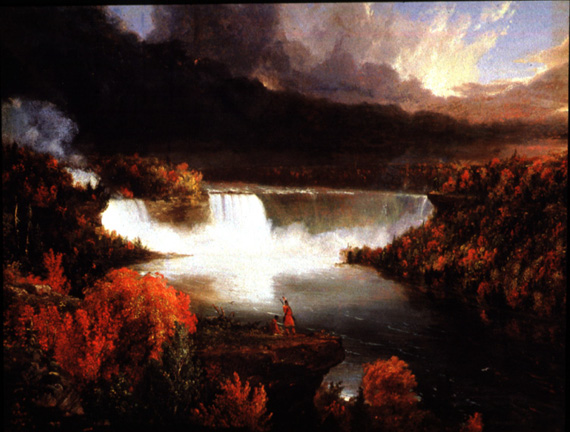LITR 5535: American
Romanticism

Student Presentation on Reading Selections 2006
Monday 18 September: James Fenimore Cooper, N 460-469. Cooper, The Last of the Mohicans, through ch. 11 (through p. 110 Penguin edition); Samuel Clemens (Mark Twain), N 1432-1440 (“Fenimore Cooper’s Literary Offences”); handout: D. H. Lawrence on Cooper's Leatherstocking novels.
selection reader / discussion leader: Chris Wissel

Thomas Cole, Niagara Falls (1830-31)
Facts about New York’s topography:
Two upland regions—the Adirondack Mountains and the Appalachian Highlands—dominate the topography of New York State.
The Adirondacks cover most of the northeast and occupy about one-fourth of the state's total area. The Appalachian Highlands, including the Catskill Mountains and Kittatinny Mountain Ridge (or Shawangunk Mountains), extend across the southern half of the state. Between these two upland regions, and also along the state's northern and eastern borders, lies a network of lowlands, including the Great Lakes Plain; the Hudson, Mohawk, Lake Champlain, and St. Lawrence valleys; and the coastal areas of New York City and Long Island.
The state's highest peaks are found in the Adirondacks: Mt. March, 5,344 feet (1,629 meters), and Algonquin Peak, 5,114 feet (1,559 meters). The highest peak in the Catskills is Slide Mountain, at 4,204 feet (1,281 meters). Lesser upland regions of New York include the Hudson Highlands, projecting into the Hudson Valley; the Taconic Range, along the state's eastern border; and Tug Hill Plateau, set amid the lowlands just west of the Adirondacks.
New York contains some 8,000 lakes. Nestled among the Adirondacks are many lakes, including Lake Placid, Saranac Lake, and Lake George. The region is also the source of the Hudson and Ausable rivers.
New York's longest river is the Hudson, extending from the Adirondacks to New York Bay for a distance of 306 mi (492 km). The Mohawk River flows into the Hudson north of Albany. The major rivers of central and western New York State—the Black, Genesee, and Oswego—all flow into Lake Ontario. Rivers defining the state's borders are the St. Lawrence in the north, the Poultney in the east, the Delaware in the southeast, and the Niagara in the west.
Objective 1a. Romantic Spirit or Ideology:
To identify and criticize ideas and attitudes associated with Romanticism,
such as desire and loss, rebellion, nostalgia, idealism, the gothic, the
sublime, the individual in nature or
separate from the masses.
Objective 1c: Romantic Genres: To describe & evaluate the gothic novel or style (haunted physical and mental spaces, the shadow of death or decay; dark and light in physical and moral terms; film noir).
From Chapter Five, p. 45:
“Glancing
his eyes around, with a vain effort to pierce the gloom that was thickening
beneath the leafy arches of the forest, he felt as if, cut off from human aid,
his unresisting companions would soon lie at the entire mercy of those barbarous
enemies, who, like beasts of prey, only waited till the gathering darkness might
render their blows more fatally certain. His awakened imagination, deluded by
the deceptive light, converted each waving bush, or the fragment of some fallen
tree, into human forms, and twenty times he fancied he could distinguish the
horrid visages of his lurking foes, peering from their hiding places, in never
ceasing watchfulness of the movements of his party. Looking upward, he found
that the thin fleecy clouds, which evening had painted on the blue sky, were
already losing their faintest tints of rose-color, while the imbedded stream,
which glided past the spot where he stood, was to be traced only by the dark
boundary of its wooded banks.”
How do Cooper’s visual descriptions
reflect the gothic style? How does he use these descriptions to serve the
narrative?
How is Duncan’s perspective in the novel a physical or mental journey?
From Chapter Six, p. 59:
“The
natural taste and true ear of David governed and modified the sounds to suit the
confined cavern, every crevice and cranny of which was filled with the thrilling
notes of their flexible voices. The Indians riveted their eyes on the rocks, and
listened with an attention that seemed to turn them into stone. But the scout,
who had placed his chin in his hand, with an expression of cold indifference,
gradually suffered his rigid features to relax, until, as verse succeeded verse,
he felt his iron nature subdued, while his recollection was carried back to
boyhood, when his ears had been accustomed to listen to similar sounds of
praise, in the settlements of the colony. His roving eyes began to moisten, and
before the hymn was ended scalding tears rolled out of fountains that had long
seemed dry, and followed each other down those cheeks, that had oftener felt the
storms of heaven than any testimonials of weakness. The singers were dwelling on
one of those low, dying chords, which the ear devours with such greedy rapture,
as if conscious that it is about to lose them, when a cry, that seemed neither
human nor earthly, rose in the outward air, penetrating not only the recesses of
the cavern, but to the inmost hearts of all who heard it. It was followed by a
stillness apparently as deep as if the waters had been checked in their furious
progress, at such a horrid and unusual interruption.”
How
do the characters in the passage display the various attitudes associated with
Romanticism?
How
does David Gamut, and his psalmody, affect the gothic wilderness?
|
|
|
|

